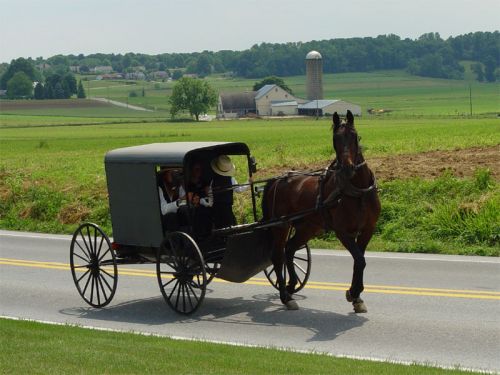 Meg Jones of the Milwaukee Journal Sentinel had a thorough article recently on Amish beliefs and customs and their collision with local Wisconsin municipalities and state laws and regulations. I would cite the article as a good example of a reporter reaching out to learn about the beliefs and faith-based traditions of a group of people who are often not understood very well by the general public.
Jones also did a solid job explaining that this conflict comes down to religious freedom and whether state and local governments have the constitutional authority to override those freedoms. She also clearly spent a great deal of time with this story and includes many recent examples of local governments colliding with the Amish lifestyle.
Meg Jones of the Milwaukee Journal Sentinel had a thorough article recently on Amish beliefs and customs and their collision with local Wisconsin municipalities and state laws and regulations. I would cite the article as a good example of a reporter reaching out to learn about the beliefs and faith-based traditions of a group of people who are often not understood very well by the general public.
Jones also did a solid job explaining that this conflict comes down to religious freedom and whether state and local governments have the constitutional authority to override those freedoms. She also clearly spent a great deal of time with this story and includes many recent examples of local governments colliding with the Amish lifestyle.
It was the latest in a growing number of clashes between the Amish and governments in Wisconsin:
*An Amish man in Jackson County was fined $10,000 in March for failing to get a building permit. He was part of a small group of Amish farmers who did not get building permits because they say conforming to the state's uniform dwelling code is against their beliefs.
*An Amish couple in Clark County was ordered last month to shut down their candy and jam business because they were running an unlicensed food processing establishment.
*A refusal by some Amish farmers to comply with the state's livestock premises registration law -- designed to quickly locate livestock herds in a disease outbreak -- could lead to a showdown in court. Some Amish fear that if they register their farms, it could lead to the state requiring them to register their animals individually. They say that would be akin to "the number of the beast" in the Book of Revelation.
The culture collision might be due to the growth of Amish in places where municipalities are not accustomed to the group's simple lifestyle that shuns electricity, phones and motor vehicles.
I doubt these types of incidents are unique to the state of Wisconsin. Pennsylvania, Indiana and Ohio are all known to have significant Amish populations.
A Google News search for the term "Amish" Thursday afternoon revealed a surprising number of articles about the Amish and their involvement in the American legal system.
In Kentucky, the American Civil Liberties Union has agreed to defend some Amish men who are charged with failing to display "slow-moving vehicle emblems on their horse-drawn buggies." In Blair County, Pennsylvania, neighbors of an Amish family are asking a county judge to "reconsider his ruling over noise levels generated by the family's sawmill and furniture shop." In Long Prairie, Minnesota, an Amish man was hurt in an accident while he was driving his buggy.
The St. Louis Post-Dispatch recently had to agonize over the decision of whether or not to run a photo of Amish related to a story of a tragic accident involving Amish traveling in automobiles to a funeral. As a result the photo editor took some time to learn more about the Amish community and their culture and wants readers to know about "the thought and research that is behind the decisions" made daily at the newspaper.
In covering these types incidents and the Amish in general, reporters should do some research their beliefs. They are hardly a unified group in terms of what they believe is right or wrong in their interactions with modern society. Amish may be hard for outsiders to distinguish from the Old Order Mennonites, Hutterites and Old German Baptist Brethren, but they are each distinct groups within the Anabaptist movement.
Within Amish communities there have also been many divisions. Groups are known to break-up over arguments on hat-brim width or a buggy's color. The most resistant to change has been the Old Order Amish. As these cases head to court and as legislatures struggle with how to accommodate the religious beliefs of these groups, it will be interesting to see if officials highlight Amish who are not as resistant to change and are less committed to the traditional way of life that in many ways defines Amish.
Photo is of a traditional Amish buggy, Lancaster County, Pa., used under a license from Wikimedia Commons. This photo of a covered Amish buggy is instructive for understanding some of the divisions within the Amish communities. A buggy with a cover would not be as accepted by the some of the most traditional Old Order Amish.
